Employee Relations: Conflict Resolution, Negotiation at Tesco PLC
VerifiedAdded on 2023/04/17
|14
|3579
|176
Report
AI Summary
This report delves into the employee relations landscape at Tesco PLC, examining the interplay between management and employees within a changing work environment. It contrasts unitary and pluralistic perspectives to understand employee mindsets and explores the role of trade unions in sha...

Employee Relation
1
1
Paraphrase This Document
Need a fresh take? Get an instant paraphrase of this document with our AI Paraphraser
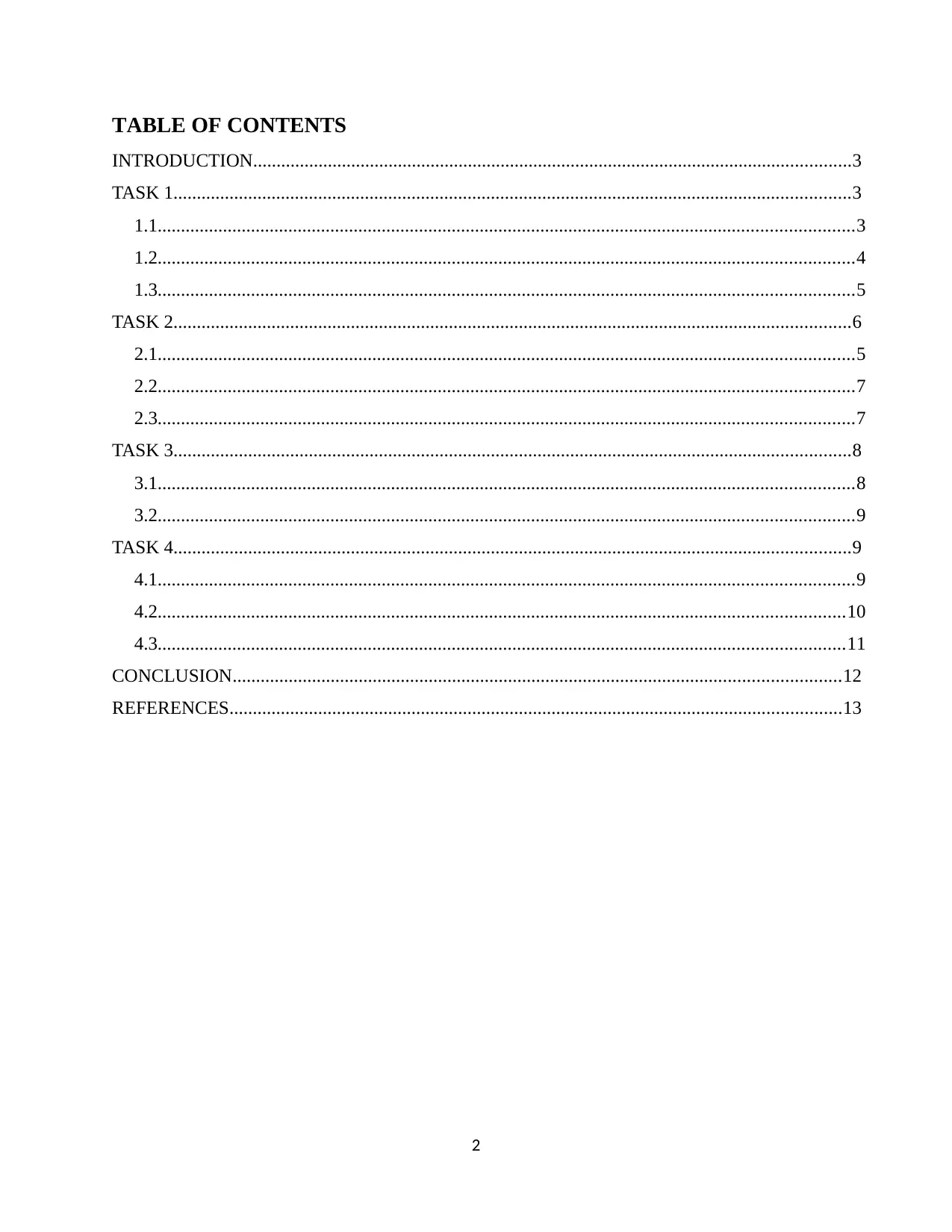
TABLE OF CONTENTS
INTRODUCTION................................................................................................................................3
TASK 1.................................................................................................................................................3
1.1.....................................................................................................................................................3
1.2.....................................................................................................................................................4
1.3.....................................................................................................................................................5
TASK 2.................................................................................................................................................6
2.1.....................................................................................................................................................5
2.2.....................................................................................................................................................7
2.3.....................................................................................................................................................7
TASK 3.................................................................................................................................................8
3.1.....................................................................................................................................................8
3.2.....................................................................................................................................................9
TASK 4.................................................................................................................................................9
4.1.....................................................................................................................................................9
4.2...................................................................................................................................................10
4.3...................................................................................................................................................11
CONCLUSION..................................................................................................................................12
REFERENCES...................................................................................................................................13
2
INTRODUCTION................................................................................................................................3
TASK 1.................................................................................................................................................3
1.1.....................................................................................................................................................3
1.2.....................................................................................................................................................4
1.3.....................................................................................................................................................5
TASK 2.................................................................................................................................................6
2.1.....................................................................................................................................................5
2.2.....................................................................................................................................................7
2.3.....................................................................................................................................................7
TASK 3.................................................................................................................................................8
3.1.....................................................................................................................................................8
3.2.....................................................................................................................................................9
TASK 4.................................................................................................................................................9
4.1.....................................................................................................................................................9
4.2...................................................................................................................................................10
4.3...................................................................................................................................................11
CONCLUSION..................................................................................................................................12
REFERENCES...................................................................................................................................13
2
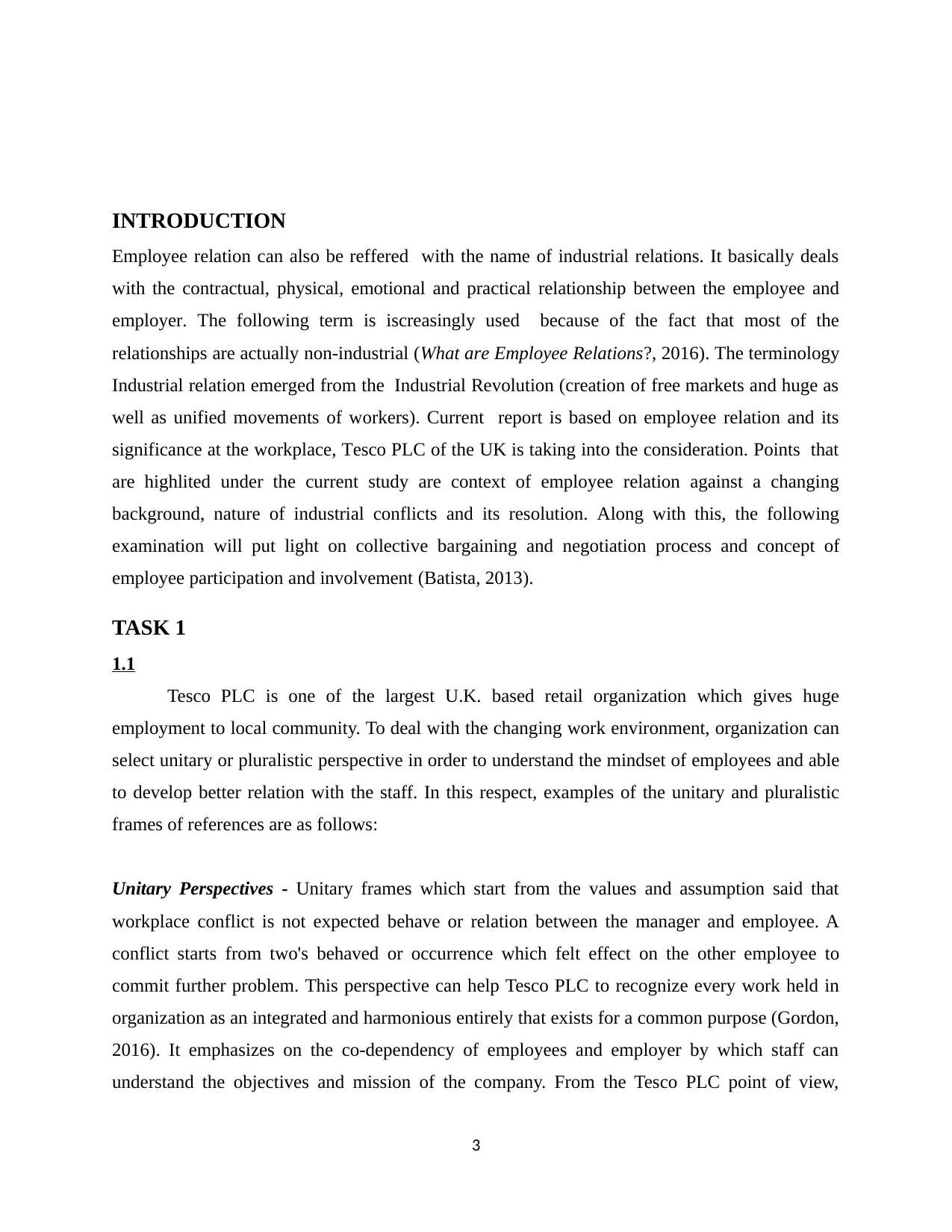
INTRODUCTION
Employee relation can also be reffered with the name of industrial relations. It basically deals
with the contractual, physical, emotional and practical relationship between the employee and
employer. The following term is iscreasingly used because of the fact that most of the
relationships are actually non-industrial (What are Employee Relations?, 2016). The terminology
Industrial relation emerged from the Industrial Revolution (creation of free markets and huge as
well as unified movements of workers). Current report is based on employee relation and its
significance at the workplace, Tesco PLC of the UK is taking into the consideration. Points that
are highlited under the current study are context of employee relation against a changing
background, nature of industrial conflicts and its resolution. Along with this, the following
examination will put light on collective bargaining and negotiation process and concept of
employee participation and involvement (Batista, 2013).
TASK 1
1.1
Tesco PLC is one of the largest U.K. based retail organization which gives huge
employment to local community. To deal with the changing work environment, organization can
select unitary or pluralistic perspective in order to understand the mindset of employees and able
to develop better relation with the staff. In this respect, examples of the unitary and pluralistic
frames of references are as follows:
Unitary Perspectives - Unitary frames which start from the values and assumption said that
workplace conflict is not expected behave or relation between the manager and employee. A
conflict starts from two's behaved or occurrence which felt effect on the other employee to
commit further problem. This perspective can help Tesco PLC to recognize every work held in
organization as an integrated and harmonious entirely that exists for a common purpose (Gordon,
2016). It emphasizes on the co-dependency of employees and employer by which staff can
understand the objectives and mission of the company. From the Tesco PLC point of view,
3
Employee relation can also be reffered with the name of industrial relations. It basically deals
with the contractual, physical, emotional and practical relationship between the employee and
employer. The following term is iscreasingly used because of the fact that most of the
relationships are actually non-industrial (What are Employee Relations?, 2016). The terminology
Industrial relation emerged from the Industrial Revolution (creation of free markets and huge as
well as unified movements of workers). Current report is based on employee relation and its
significance at the workplace, Tesco PLC of the UK is taking into the consideration. Points that
are highlited under the current study are context of employee relation against a changing
background, nature of industrial conflicts and its resolution. Along with this, the following
examination will put light on collective bargaining and negotiation process and concept of
employee participation and involvement (Batista, 2013).
TASK 1
1.1
Tesco PLC is one of the largest U.K. based retail organization which gives huge
employment to local community. To deal with the changing work environment, organization can
select unitary or pluralistic perspective in order to understand the mindset of employees and able
to develop better relation with the staff. In this respect, examples of the unitary and pluralistic
frames of references are as follows:
Unitary Perspectives - Unitary frames which start from the values and assumption said that
workplace conflict is not expected behave or relation between the manager and employee. A
conflict starts from two's behaved or occurrence which felt effect on the other employee to
commit further problem. This perspective can help Tesco PLC to recognize every work held in
organization as an integrated and harmonious entirely that exists for a common purpose (Gordon,
2016). It emphasizes on the co-dependency of employees and employer by which staff can
understand the objectives and mission of the company. From the Tesco PLC point of view,
3
⊘ This is a preview!⊘
Do you want full access?
Subscribe today to unlock all pages.

Trusted by 1+ million students worldwide
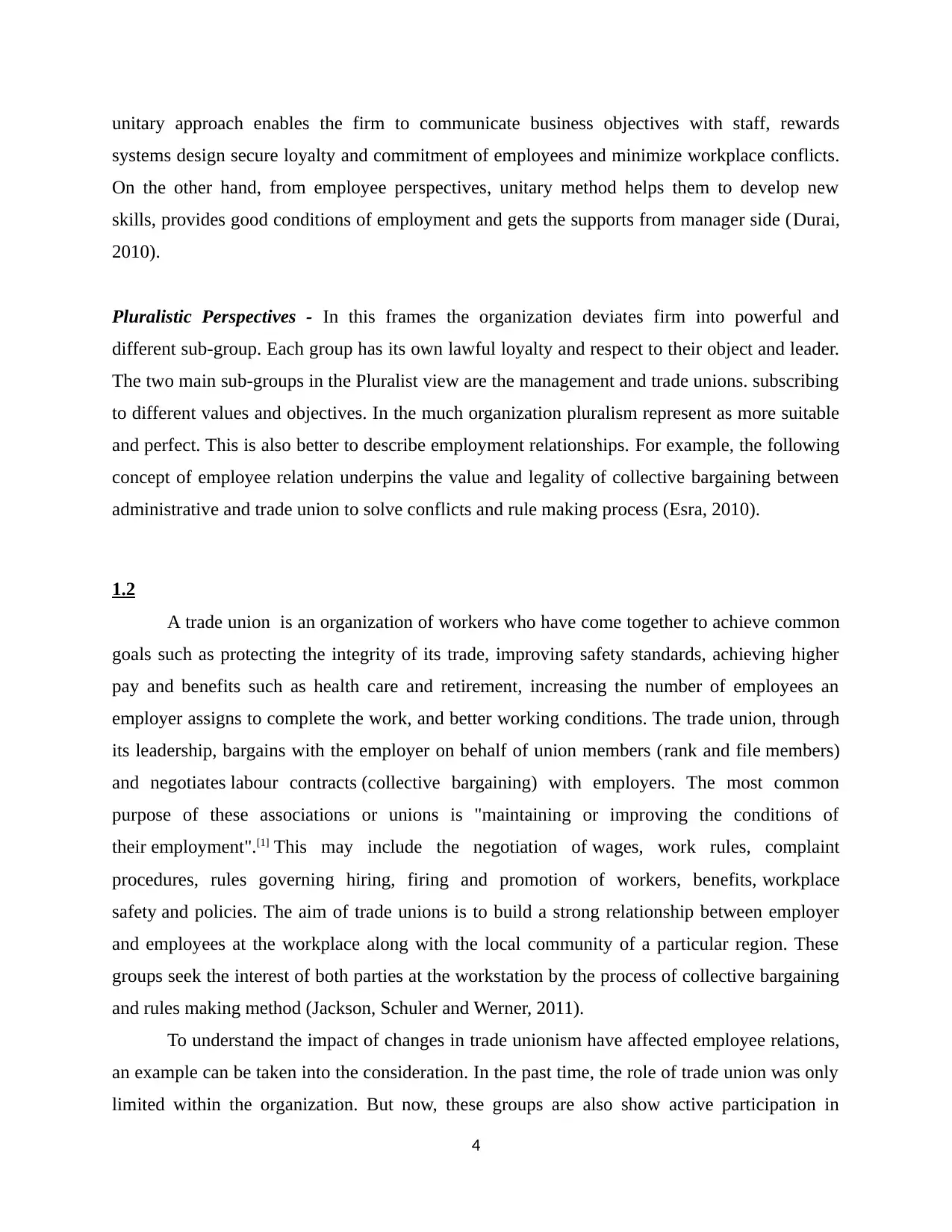
unitary approach enables the firm to communicate business objectives with staff, rewards
systems design secure loyalty and commitment of employees and minimize workplace conflicts.
On the other hand, from employee perspectives, unitary method helps them to develop new
skills, provides good conditions of employment and gets the supports from manager side (Durai,
2010).
Pluralistic Perspectives - In this frames the organization deviates firm into powerful and
different sub-group. Each group has its own lawful loyalty and respect to their object and leader.
The two main sub-groups in the Pluralist view are the management and trade unions. subscribing
to different values and objectives. In the much organization pluralism represent as more suitable
and perfect. This is also better to describe employment relationships. For example, the following
concept of employee relation underpins the value and legality of collective bargaining between
administrative and trade union to solve conflicts and rule making process (Esra, 2010).
1.2
A trade union is an organization of workers who have come together to achieve common
goals such as protecting the integrity of its trade, improving safety standards, achieving higher
pay and benefits such as health care and retirement, increasing the number of employees an
employer assigns to complete the work, and better working conditions. The trade union, through
its leadership, bargains with the employer on behalf of union members (rank and file members)
and negotiates labour contracts (collective bargaining) with employers. The most common
purpose of these associations or unions is "maintaining or improving the conditions of
their employment".[1] This may include the negotiation of wages, work rules, complaint
procedures, rules governing hiring, firing and promotion of workers, benefits, workplace
safety and policies. The aim of trade unions is to build a strong relationship between employer
and employees at the workplace along with the local community of a particular region. These
groups seek the interest of both parties at the workstation by the process of collective bargaining
and rules making method (Jackson, Schuler and Werner, 2011).
To understand the impact of changes in trade unionism have affected employee relations,
an example can be taken into the consideration. In the past time, the role of trade union was only
limited within the organization. But now, these groups are also show active participation in
4
systems design secure loyalty and commitment of employees and minimize workplace conflicts.
On the other hand, from employee perspectives, unitary method helps them to develop new
skills, provides good conditions of employment and gets the supports from manager side (Durai,
2010).
Pluralistic Perspectives - In this frames the organization deviates firm into powerful and
different sub-group. Each group has its own lawful loyalty and respect to their object and leader.
The two main sub-groups in the Pluralist view are the management and trade unions. subscribing
to different values and objectives. In the much organization pluralism represent as more suitable
and perfect. This is also better to describe employment relationships. For example, the following
concept of employee relation underpins the value and legality of collective bargaining between
administrative and trade union to solve conflicts and rule making process (Esra, 2010).
1.2
A trade union is an organization of workers who have come together to achieve common
goals such as protecting the integrity of its trade, improving safety standards, achieving higher
pay and benefits such as health care and retirement, increasing the number of employees an
employer assigns to complete the work, and better working conditions. The trade union, through
its leadership, bargains with the employer on behalf of union members (rank and file members)
and negotiates labour contracts (collective bargaining) with employers. The most common
purpose of these associations or unions is "maintaining or improving the conditions of
their employment".[1] This may include the negotiation of wages, work rules, complaint
procedures, rules governing hiring, firing and promotion of workers, benefits, workplace
safety and policies. The aim of trade unions is to build a strong relationship between employer
and employees at the workplace along with the local community of a particular region. These
groups seek the interest of both parties at the workstation by the process of collective bargaining
and rules making method (Jackson, Schuler and Werner, 2011).
To understand the impact of changes in trade unionism have affected employee relations,
an example can be taken into the consideration. In the past time, the role of trade union was only
limited within the organization. But now, these groups are also show active participation in
4
Paraphrase This Document
Need a fresh take? Get an instant paraphrase of this document with our AI Paraphraser
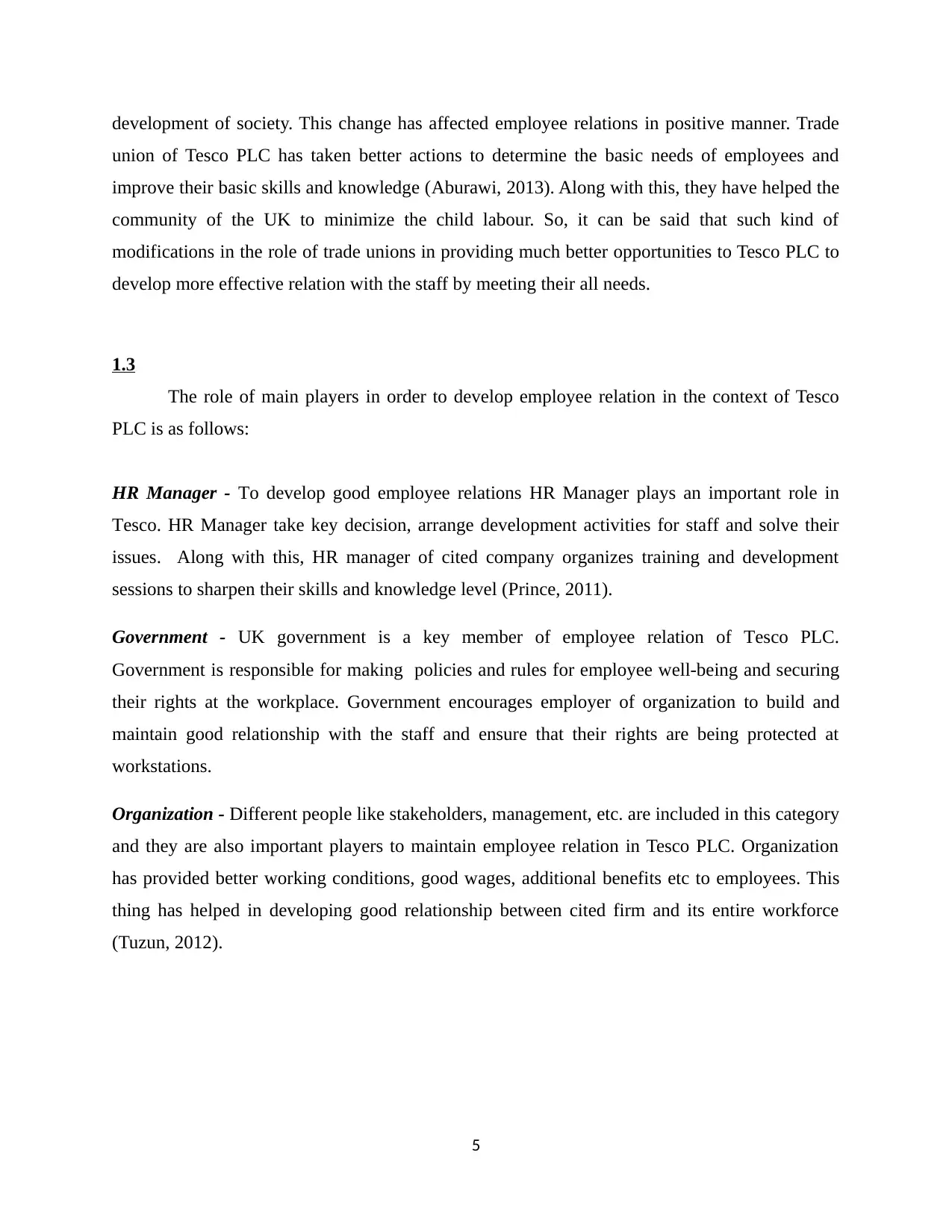
development of society. This change has affected employee relations in positive manner. Trade
union of Tesco PLC has taken better actions to determine the basic needs of employees and
improve their basic skills and knowledge (Aburawi, 2013). Along with this, they have helped the
community of the UK to minimize the child labour. So, it can be said that such kind of
modifications in the role of trade unions in providing much better opportunities to Tesco PLC to
develop more effective relation with the staff by meeting their all needs.
1.3
The role of main players in order to develop employee relation in the context of Tesco
PLC is as follows:
HR Manager - To develop good employee relations HR Manager plays an important role in
Tesco. HR Manager take key decision, arrange development activities for staff and solve their
issues. Along with this, HR manager of cited company organizes training and development
sessions to sharpen their skills and knowledge level (Prince, 2011).
Government - UK government is a key member of employee relation of Tesco PLC.
Government is responsible for making policies and rules for employee well-being and securing
their rights at the workplace. Government encourages employer of organization to build and
maintain good relationship with the staff and ensure that their rights are being protected at
workstations.
Organization - Different people like stakeholders, management, etc. are included in this category
and they are also important players to maintain employee relation in Tesco PLC. Organization
has provided better working conditions, good wages, additional benefits etc to employees. This
thing has helped in developing good relationship between cited firm and its entire workforce
(Tuzun, 2012).
5
union of Tesco PLC has taken better actions to determine the basic needs of employees and
improve their basic skills and knowledge (Aburawi, 2013). Along with this, they have helped the
community of the UK to minimize the child labour. So, it can be said that such kind of
modifications in the role of trade unions in providing much better opportunities to Tesco PLC to
develop more effective relation with the staff by meeting their all needs.
1.3
The role of main players in order to develop employee relation in the context of Tesco
PLC is as follows:
HR Manager - To develop good employee relations HR Manager plays an important role in
Tesco. HR Manager take key decision, arrange development activities for staff and solve their
issues. Along with this, HR manager of cited company organizes training and development
sessions to sharpen their skills and knowledge level (Prince, 2011).
Government - UK government is a key member of employee relation of Tesco PLC.
Government is responsible for making policies and rules for employee well-being and securing
their rights at the workplace. Government encourages employer of organization to build and
maintain good relationship with the staff and ensure that their rights are being protected at
workstations.
Organization - Different people like stakeholders, management, etc. are included in this category
and they are also important players to maintain employee relation in Tesco PLC. Organization
has provided better working conditions, good wages, additional benefits etc to employees. This
thing has helped in developing good relationship between cited firm and its entire workforce
(Tuzun, 2012).
5
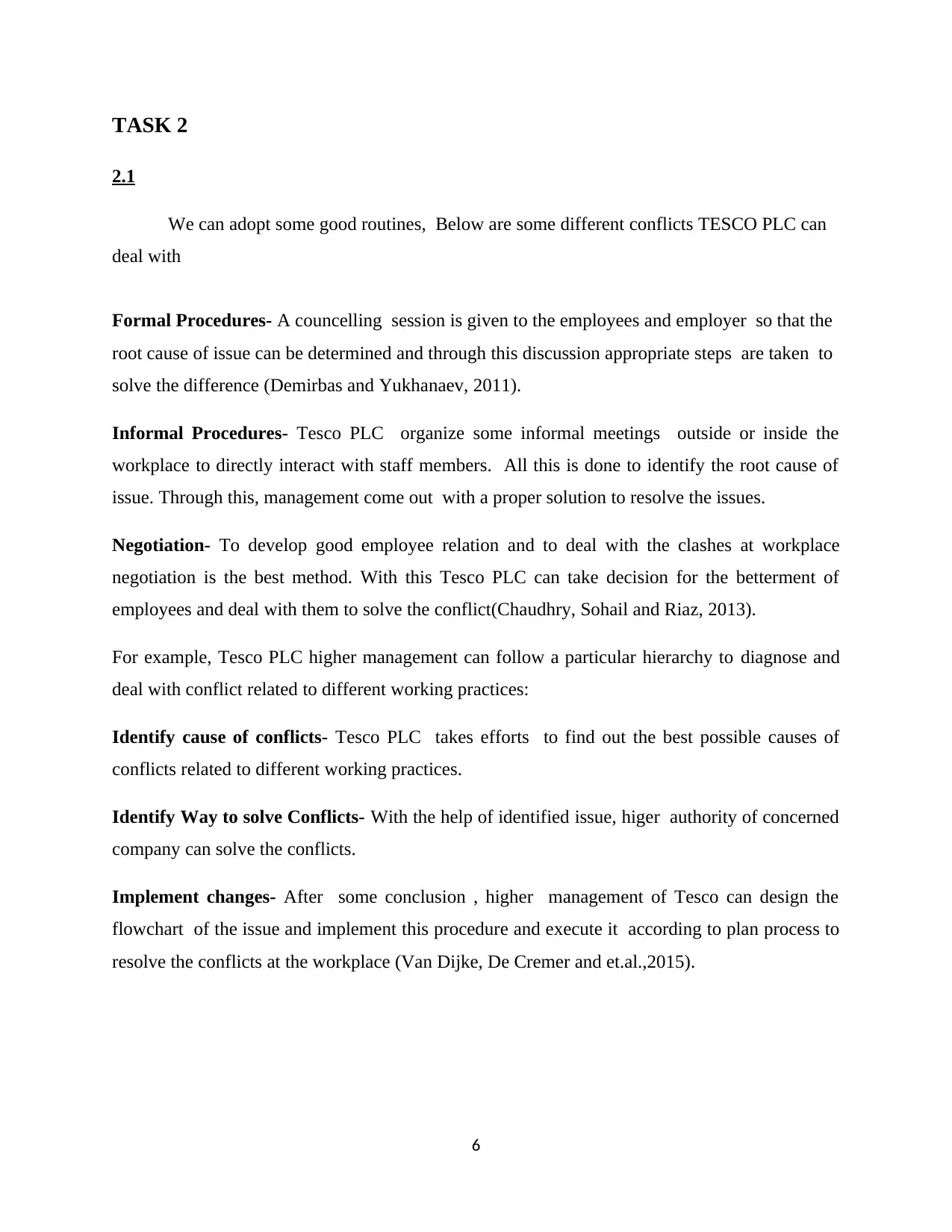
TASK 2
2.1
We can adopt some good routines, Below are some different conflicts TESCO PLC can
deal with
Formal Procedures- A councelling session is given to the employees and employer so that the
root cause of issue can be determined and through this discussion appropriate steps are taken to
solve the difference (Demirbas and Yukhanaev, 2011).
Informal Procedures- Tesco PLC organize some informal meetings outside or inside the
workplace to directly interact with staff members. All this is done to identify the root cause of
issue. Through this, management come out with a proper solution to resolve the issues.
Negotiation- To develop good employee relation and to deal with the clashes at workplace
negotiation is the best method. With this Tesco PLC can take decision for the betterment of
employees and deal with them to solve the conflict(Chaudhry, Sohail and Riaz, 2013).
For example, Tesco PLC higher management can follow a particular hierarchy to diagnose and
deal with conflict related to different working practices:
Identify cause of conflicts- Tesco PLC takes efforts to find out the best possible causes of
conflicts related to different working practices.
Identify Way to solve Conflicts- With the help of identified issue, higer authority of concerned
company can solve the conflicts.
Implement changes- After some conclusion , higher management of Tesco can design the
flowchart of the issue and implement this procedure and execute it according to plan process to
resolve the conflicts at the workplace (Van Dijke, De Cremer and et.al.,2015).
6
2.1
We can adopt some good routines, Below are some different conflicts TESCO PLC can
deal with
Formal Procedures- A councelling session is given to the employees and employer so that the
root cause of issue can be determined and through this discussion appropriate steps are taken to
solve the difference (Demirbas and Yukhanaev, 2011).
Informal Procedures- Tesco PLC organize some informal meetings outside or inside the
workplace to directly interact with staff members. All this is done to identify the root cause of
issue. Through this, management come out with a proper solution to resolve the issues.
Negotiation- To develop good employee relation and to deal with the clashes at workplace
negotiation is the best method. With this Tesco PLC can take decision for the betterment of
employees and deal with them to solve the conflict(Chaudhry, Sohail and Riaz, 2013).
For example, Tesco PLC higher management can follow a particular hierarchy to diagnose and
deal with conflict related to different working practices:
Identify cause of conflicts- Tesco PLC takes efforts to find out the best possible causes of
conflicts related to different working practices.
Identify Way to solve Conflicts- With the help of identified issue, higer authority of concerned
company can solve the conflicts.
Implement changes- After some conclusion , higher management of Tesco can design the
flowchart of the issue and implement this procedure and execute it according to plan process to
resolve the conflicts at the workplace (Van Dijke, De Cremer and et.al.,2015).
6
⊘ This is a preview!⊘
Do you want full access?
Subscribe today to unlock all pages.

Trusted by 1+ million students worldwide
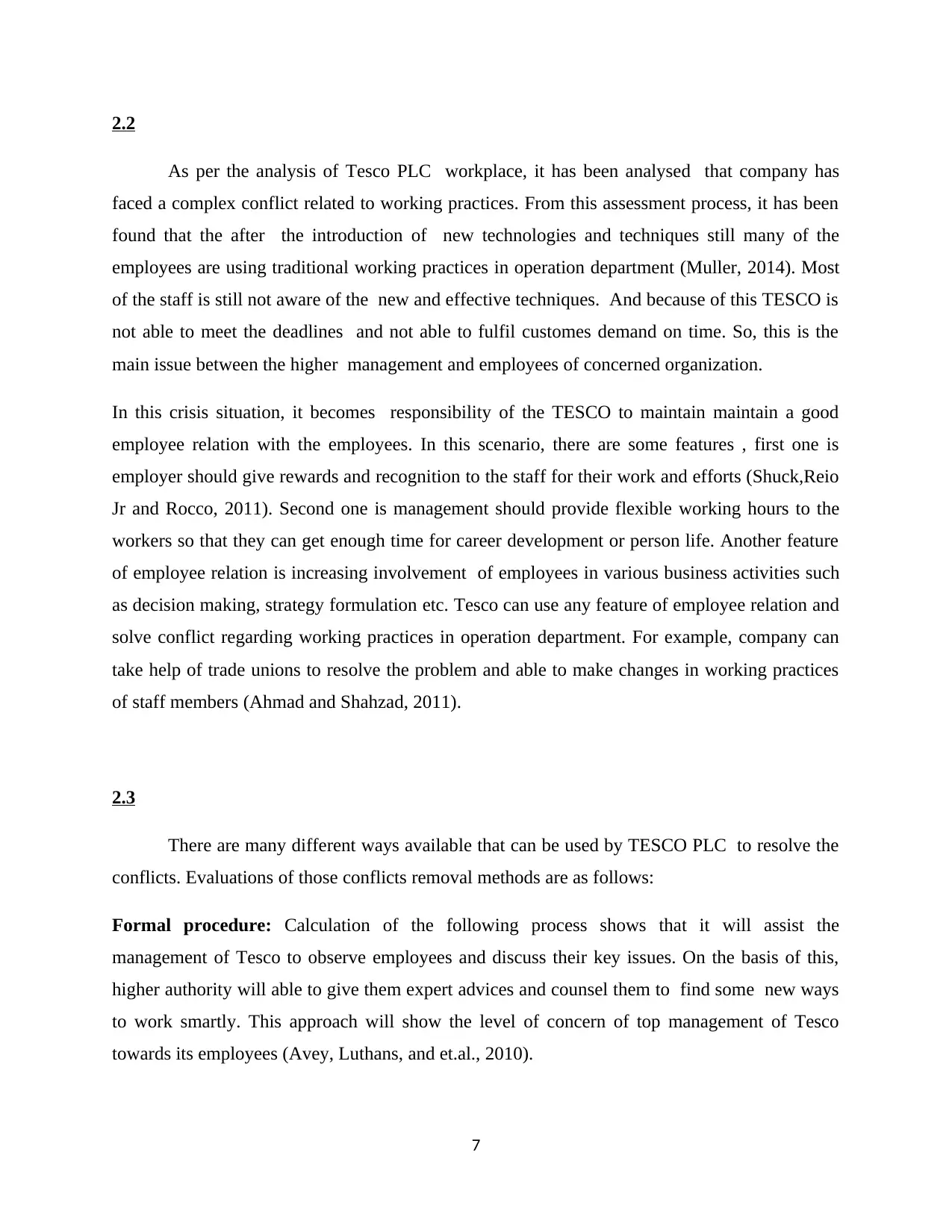
2.2
As per the analysis of Tesco PLC workplace, it has been analysed that company has
faced a complex conflict related to working practices. From this assessment process, it has been
found that the after the introduction of new technologies and techniques still many of the
employees are using traditional working practices in operation department (Muller, 2014). Most
of the staff is still not aware of the new and effective techniques. And because of this TESCO is
not able to meet the deadlines and not able to fulfil customes demand on time. So, this is the
main issue between the higher management and employees of concerned organization.
In this crisis situation, it becomes responsibility of the TESCO to maintain maintain a good
employee relation with the employees. In this scenario, there are some features , first one is
employer should give rewards and recognition to the staff for their work and efforts (Shuck,Reio
Jr and Rocco, 2011). Second one is management should provide flexible working hours to the
workers so that they can get enough time for career development or person life. Another feature
of employee relation is increasing involvement of employees in various business activities such
as decision making, strategy formulation etc. Tesco can use any feature of employee relation and
solve conflict regarding working practices in operation department. For example, company can
take help of trade unions to resolve the problem and able to make changes in working practices
of staff members (Ahmad and Shahzad, 2011).
2.3
There are many different ways available that can be used by TESCO PLC to resolve the
conflicts. Evaluations of those conflicts removal methods are as follows:
Formal procedure: Calculation of the following process shows that it will assist the
management of Tesco to observe employees and discuss their key issues. On the basis of this,
higher authority will able to give them expert advices and counsel them to find some new ways
to work smartly. This approach will show the level of concern of top management of Tesco
towards its employees (Avey, Luthans, and et.al., 2010).
7
As per the analysis of Tesco PLC workplace, it has been analysed that company has
faced a complex conflict related to working practices. From this assessment process, it has been
found that the after the introduction of new technologies and techniques still many of the
employees are using traditional working practices in operation department (Muller, 2014). Most
of the staff is still not aware of the new and effective techniques. And because of this TESCO is
not able to meet the deadlines and not able to fulfil customes demand on time. So, this is the
main issue between the higher management and employees of concerned organization.
In this crisis situation, it becomes responsibility of the TESCO to maintain maintain a good
employee relation with the employees. In this scenario, there are some features , first one is
employer should give rewards and recognition to the staff for their work and efforts (Shuck,Reio
Jr and Rocco, 2011). Second one is management should provide flexible working hours to the
workers so that they can get enough time for career development or person life. Another feature
of employee relation is increasing involvement of employees in various business activities such
as decision making, strategy formulation etc. Tesco can use any feature of employee relation and
solve conflict regarding working practices in operation department. For example, company can
take help of trade unions to resolve the problem and able to make changes in working practices
of staff members (Ahmad and Shahzad, 2011).
2.3
There are many different ways available that can be used by TESCO PLC to resolve the
conflicts. Evaluations of those conflicts removal methods are as follows:
Formal procedure: Calculation of the following process shows that it will assist the
management of Tesco to observe employees and discuss their key issues. On the basis of this,
higher authority will able to give them expert advices and counsel them to find some new ways
to work smartly. This approach will show the level of concern of top management of Tesco
towards its employees (Avey, Luthans, and et.al., 2010).
7
Paraphrase This Document
Need a fresh take? Get an instant paraphrase of this document with our AI Paraphraser
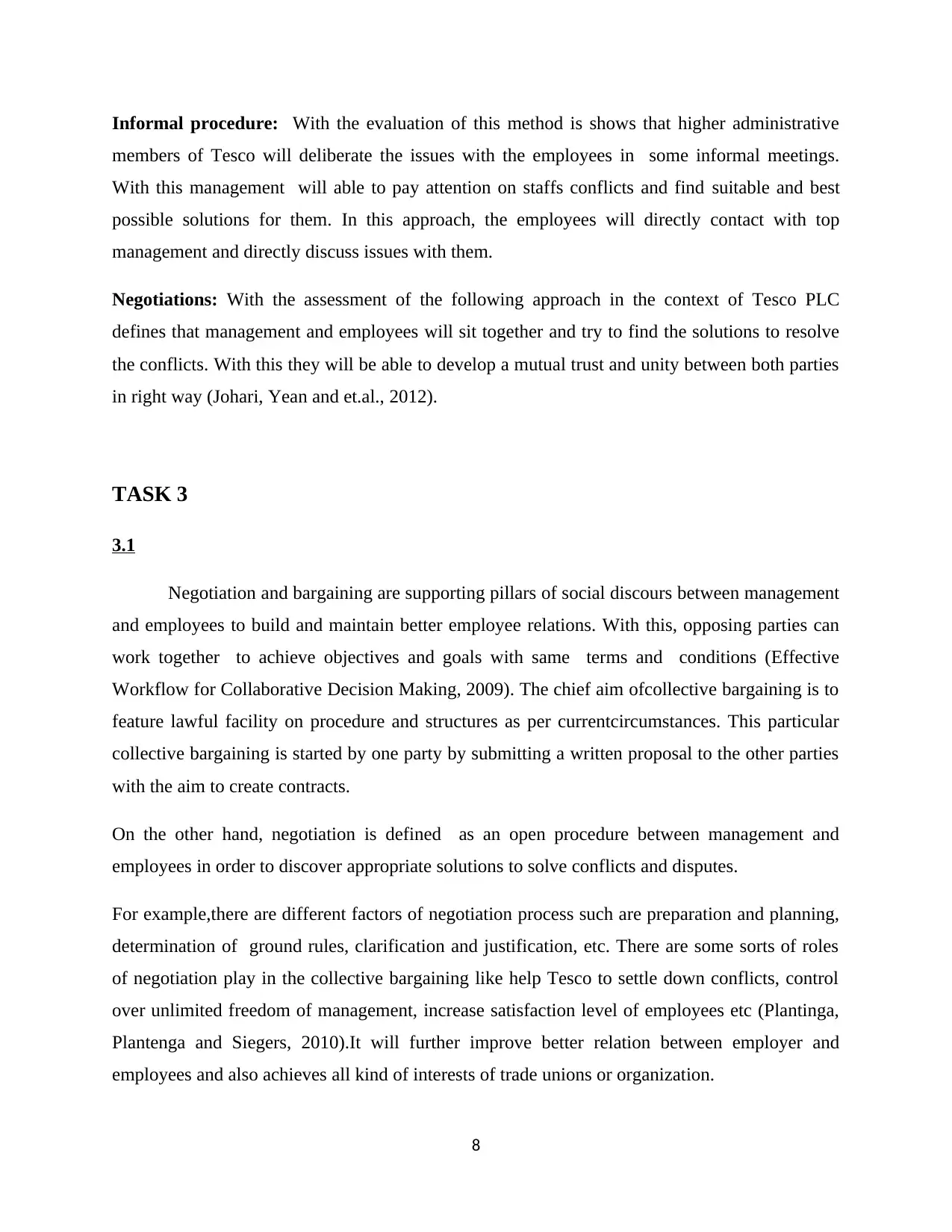
Informal procedure: With the evaluation of this method is shows that higher administrative
members of Tesco will deliberate the issues with the employees in some informal meetings.
With this management will able to pay attention on staffs conflicts and find suitable and best
possible solutions for them. In this approach, the employees will directly contact with top
management and directly discuss issues with them.
Negotiations: With the assessment of the following approach in the context of Tesco PLC
defines that management and employees will sit together and try to find the solutions to resolve
the conflicts. With this they will be able to develop a mutual trust and unity between both parties
in right way (Johari, Yean and et.al., 2012).
TASK 3
3.1
Negotiation and bargaining are supporting pillars of social discours between management
and employees to build and maintain better employee relations. With this, opposing parties can
work together to achieve objectives and goals with same terms and conditions (Effective
Workflow for Collaborative Decision Making, 2009). The chief aim ofcollective bargaining is to
feature lawful facility on procedure and structures as per currentcircumstances. This particular
collective bargaining is started by one party by submitting a written proposal to the other parties
with the aim to create contracts.
On the other hand, negotiation is defined as an open procedure between management and
employees in order to discover appropriate solutions to solve conflicts and disputes.
For example,there are different factors of negotiation process such are preparation and planning,
determination of ground rules, clarification and justification, etc. There are some sorts of roles
of negotiation play in the collective bargaining like help Tesco to settle down conflicts, control
over unlimited freedom of management, increase satisfaction level of employees etc (Plantinga,
Plantenga and Siegers, 2010).It will further improve better relation between employer and
employees and also achieves all kind of interests of trade unions or organization.
8
members of Tesco will deliberate the issues with the employees in some informal meetings.
With this management will able to pay attention on staffs conflicts and find suitable and best
possible solutions for them. In this approach, the employees will directly contact with top
management and directly discuss issues with them.
Negotiations: With the assessment of the following approach in the context of Tesco PLC
defines that management and employees will sit together and try to find the solutions to resolve
the conflicts. With this they will be able to develop a mutual trust and unity between both parties
in right way (Johari, Yean and et.al., 2012).
TASK 3
3.1
Negotiation and bargaining are supporting pillars of social discours between management
and employees to build and maintain better employee relations. With this, opposing parties can
work together to achieve objectives and goals with same terms and conditions (Effective
Workflow for Collaborative Decision Making, 2009). The chief aim ofcollective bargaining is to
feature lawful facility on procedure and structures as per currentcircumstances. This particular
collective bargaining is started by one party by submitting a written proposal to the other parties
with the aim to create contracts.
On the other hand, negotiation is defined as an open procedure between management and
employees in order to discover appropriate solutions to solve conflicts and disputes.
For example,there are different factors of negotiation process such are preparation and planning,
determination of ground rules, clarification and justification, etc. There are some sorts of roles
of negotiation play in the collective bargaining like help Tesco to settle down conflicts, control
over unlimited freedom of management, increase satisfaction level of employees etc (Plantinga,
Plantenga and Siegers, 2010).It will further improve better relation between employer and
employees and also achieves all kind of interests of trade unions or organization.
8
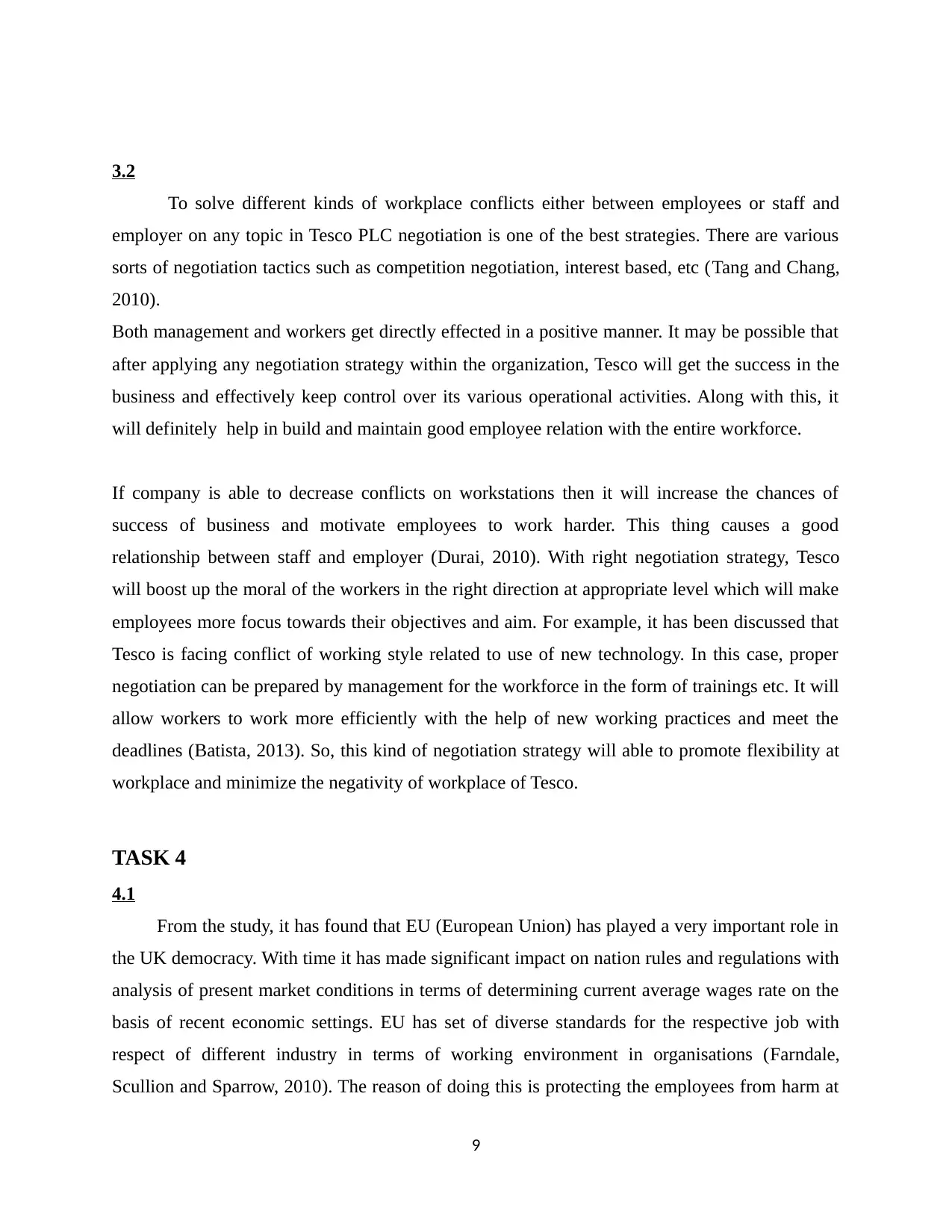
3.2
To solve different kinds of workplace conflicts either between employees or staff and
employer on any topic in Tesco PLC negotiation is one of the best strategies. There are various
sorts of negotiation tactics such as competition negotiation, interest based, etc (Tang and Chang,
2010).
Both management and workers get directly effected in a positive manner. It may be possible that
after applying any negotiation strategy within the organization, Tesco will get the success in the
business and effectively keep control over its various operational activities. Along with this, it
will definitely help in build and maintain good employee relation with the entire workforce.
If company is able to decrease conflicts on workstations then it will increase the chances of
success of business and motivate employees to work harder. This thing causes a good
relationship between staff and employer (Durai, 2010). With right negotiation strategy, Tesco
will boost up the moral of the workers in the right direction at appropriate level which will make
employees more focus towards their objectives and aim. For example, it has been discussed that
Tesco is facing conflict of working style related to use of new technology. In this case, proper
negotiation can be prepared by management for the workforce in the form of trainings etc. It will
allow workers to work more efficiently with the help of new working practices and meet the
deadlines (Batista, 2013). So, this kind of negotiation strategy will able to promote flexibility at
workplace and minimize the negativity of workplace of Tesco.
TASK 4
4.1
From the study, it has found that EU (European Union) has played a very important role in
the UK democracy. With time it has made significant impact on nation rules and regulations with
analysis of present market conditions in terms of determining current average wages rate on the
basis of recent economic settings. EU has set of diverse standards for the respective job with
respect of different industry in terms of working environment in organisations (Farndale,
Scullion and Sparrow, 2010). The reason of doing this is protecting the employees from harm at
9
To solve different kinds of workplace conflicts either between employees or staff and
employer on any topic in Tesco PLC negotiation is one of the best strategies. There are various
sorts of negotiation tactics such as competition negotiation, interest based, etc (Tang and Chang,
2010).
Both management and workers get directly effected in a positive manner. It may be possible that
after applying any negotiation strategy within the organization, Tesco will get the success in the
business and effectively keep control over its various operational activities. Along with this, it
will definitely help in build and maintain good employee relation with the entire workforce.
If company is able to decrease conflicts on workstations then it will increase the chances of
success of business and motivate employees to work harder. This thing causes a good
relationship between staff and employer (Durai, 2010). With right negotiation strategy, Tesco
will boost up the moral of the workers in the right direction at appropriate level which will make
employees more focus towards their objectives and aim. For example, it has been discussed that
Tesco is facing conflict of working style related to use of new technology. In this case, proper
negotiation can be prepared by management for the workforce in the form of trainings etc. It will
allow workers to work more efficiently with the help of new working practices and meet the
deadlines (Batista, 2013). So, this kind of negotiation strategy will able to promote flexibility at
workplace and minimize the negativity of workplace of Tesco.
TASK 4
4.1
From the study, it has found that EU (European Union) has played a very important role in
the UK democracy. With time it has made significant impact on nation rules and regulations with
analysis of present market conditions in terms of determining current average wages rate on the
basis of recent economic settings. EU has set of diverse standards for the respective job with
respect of different industry in terms of working environment in organisations (Farndale,
Scullion and Sparrow, 2010). The reason of doing this is protecting the employees from harm at
9
⊘ This is a preview!⊘
Do you want full access?
Subscribe today to unlock all pages.

Trusted by 1+ million students worldwide
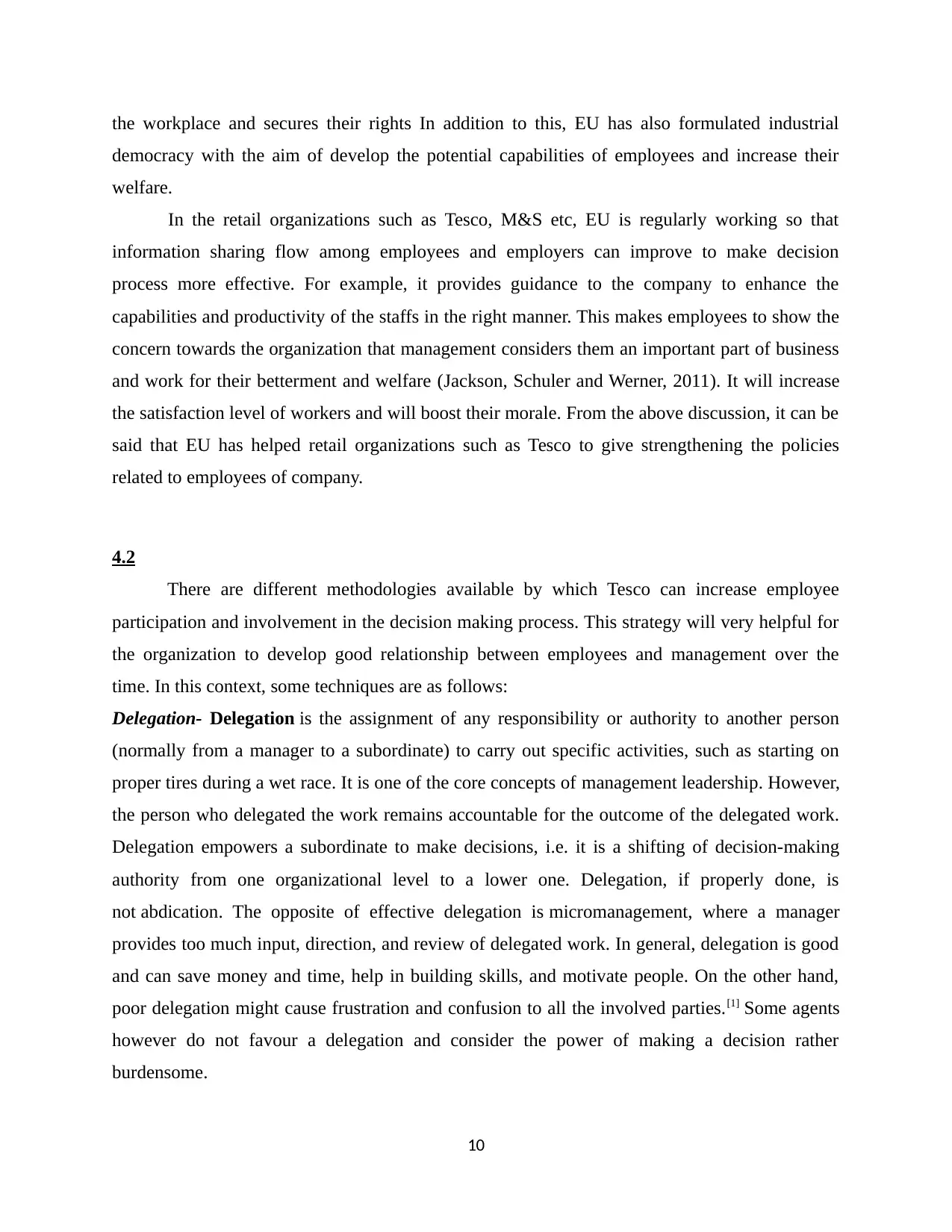
the workplace and secures their rights In addition to this, EU has also formulated industrial
democracy with the aim of develop the potential capabilities of employees and increase their
welfare.
In the retail organizations such as Tesco, M&S etc, EU is regularly working so that
information sharing flow among employees and employers can improve to make decision
process more effective. For example, it provides guidance to the company to enhance the
capabilities and productivity of the staffs in the right manner. This makes employees to show the
concern towards the organization that management considers them an important part of business
and work for their betterment and welfare (Jackson, Schuler and Werner, 2011). It will increase
the satisfaction level of workers and will boost their morale. From the above discussion, it can be
said that EU has helped retail organizations such as Tesco to give strengthening the policies
related to employees of company.
4.2
There are different methodologies available by which Tesco can increase employee
participation and involvement in the decision making process. This strategy will very helpful for
the organization to develop good relationship between employees and management over the
time. In this context, some techniques are as follows:
Delegation- Delegation is the assignment of any responsibility or authority to another person
(normally from a manager to a subordinate) to carry out specific activities, such as starting on
proper tires during a wet race. It is one of the core concepts of management leadership. However,
the person who delegated the work remains accountable for the outcome of the delegated work.
Delegation empowers a subordinate to make decisions, i.e. it is a shifting of decision-making
authority from one organizational level to a lower one. Delegation, if properly done, is
not abdication. The opposite of effective delegation is micromanagement, where a manager
provides too much input, direction, and review of delegated work. In general, delegation is good
and can save money and time, help in building skills, and motivate people. On the other hand,
poor delegation might cause frustration and confusion to all the involved parties.[1] Some agents
however do not favour a delegation and consider the power of making a decision rather
burdensome.
10
democracy with the aim of develop the potential capabilities of employees and increase their
welfare.
In the retail organizations such as Tesco, M&S etc, EU is regularly working so that
information sharing flow among employees and employers can improve to make decision
process more effective. For example, it provides guidance to the company to enhance the
capabilities and productivity of the staffs in the right manner. This makes employees to show the
concern towards the organization that management considers them an important part of business
and work for their betterment and welfare (Jackson, Schuler and Werner, 2011). It will increase
the satisfaction level of workers and will boost their morale. From the above discussion, it can be
said that EU has helped retail organizations such as Tesco to give strengthening the policies
related to employees of company.
4.2
There are different methodologies available by which Tesco can increase employee
participation and involvement in the decision making process. This strategy will very helpful for
the organization to develop good relationship between employees and management over the
time. In this context, some techniques are as follows:
Delegation- Delegation is the assignment of any responsibility or authority to another person
(normally from a manager to a subordinate) to carry out specific activities, such as starting on
proper tires during a wet race. It is one of the core concepts of management leadership. However,
the person who delegated the work remains accountable for the outcome of the delegated work.
Delegation empowers a subordinate to make decisions, i.e. it is a shifting of decision-making
authority from one organizational level to a lower one. Delegation, if properly done, is
not abdication. The opposite of effective delegation is micromanagement, where a manager
provides too much input, direction, and review of delegated work. In general, delegation is good
and can save money and time, help in building skills, and motivate people. On the other hand,
poor delegation might cause frustration and confusion to all the involved parties.[1] Some agents
however do not favour a delegation and consider the power of making a decision rather
burdensome.
10
Paraphrase This Document
Need a fresh take? Get an instant paraphrase of this document with our AI Paraphraser
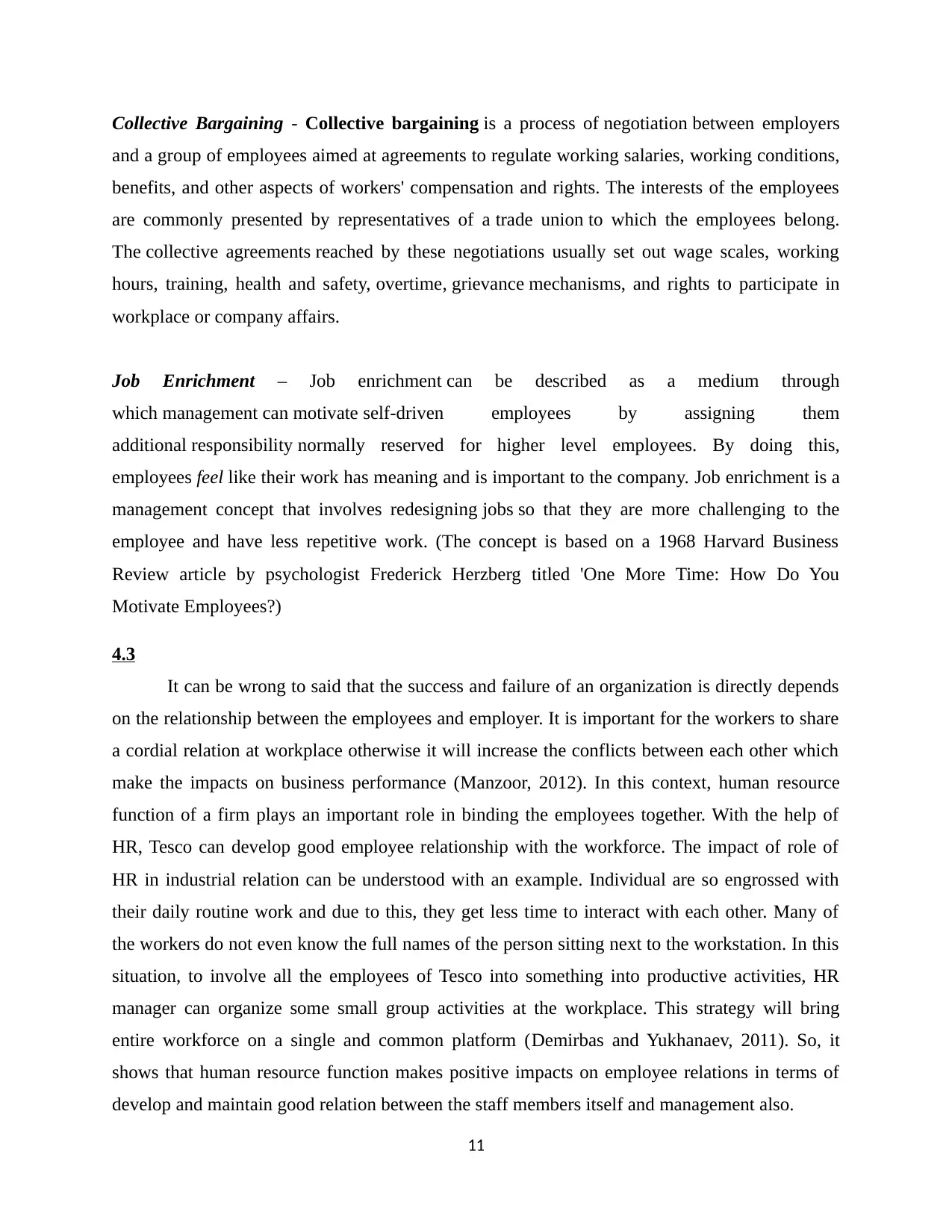
Collective Bargaining - Collective bargaining is a process of negotiation between employers
and a group of employees aimed at agreements to regulate working salaries, working conditions,
benefits, and other aspects of workers' compensation and rights. The interests of the employees
are commonly presented by representatives of a trade union to which the employees belong.
The collective agreements reached by these negotiations usually set out wage scales, working
hours, training, health and safety, overtime, grievance mechanisms, and rights to participate in
workplace or company affairs.
Job Enrichment – Job enrichment can be described as a medium through
which management can motivate self-driven employees by assigning them
additional responsibility normally reserved for higher level employees. By doing this,
employees feel like their work has meaning and is important to the company. Job enrichment is a
management concept that involves redesigning jobs so that they are more challenging to the
employee and have less repetitive work. (The concept is based on a 1968 Harvard Business
Review article by psychologist Frederick Herzberg titled 'One More Time: How Do You
Motivate Employees?)
4.3
It can be wrong to said that the success and failure of an organization is directly depends
on the relationship between the employees and employer. It is important for the workers to share
a cordial relation at workplace otherwise it will increase the conflicts between each other which
make the impacts on business performance (Manzoor, 2012). In this context, human resource
function of a firm plays an important role in binding the employees together. With the help of
HR, Tesco can develop good employee relationship with the workforce. The impact of role of
HR in industrial relation can be understood with an example. Individual are so engrossed with
their daily routine work and due to this, they get less time to interact with each other. Many of
the workers do not even know the full names of the person sitting next to the workstation. In this
situation, to involve all the employees of Tesco into something into productive activities, HR
manager can organize some small group activities at the workplace. This strategy will bring
entire workforce on a single and common platform (Demirbas and Yukhanaev, 2011). So, it
shows that human resource function makes positive impacts on employee relations in terms of
develop and maintain good relation between the staff members itself and management also.
11
and a group of employees aimed at agreements to regulate working salaries, working conditions,
benefits, and other aspects of workers' compensation and rights. The interests of the employees
are commonly presented by representatives of a trade union to which the employees belong.
The collective agreements reached by these negotiations usually set out wage scales, working
hours, training, health and safety, overtime, grievance mechanisms, and rights to participate in
workplace or company affairs.
Job Enrichment – Job enrichment can be described as a medium through
which management can motivate self-driven employees by assigning them
additional responsibility normally reserved for higher level employees. By doing this,
employees feel like their work has meaning and is important to the company. Job enrichment is a
management concept that involves redesigning jobs so that they are more challenging to the
employee and have less repetitive work. (The concept is based on a 1968 Harvard Business
Review article by psychologist Frederick Herzberg titled 'One More Time: How Do You
Motivate Employees?)
4.3
It can be wrong to said that the success and failure of an organization is directly depends
on the relationship between the employees and employer. It is important for the workers to share
a cordial relation at workplace otherwise it will increase the conflicts between each other which
make the impacts on business performance (Manzoor, 2012). In this context, human resource
function of a firm plays an important role in binding the employees together. With the help of
HR, Tesco can develop good employee relationship with the workforce. The impact of role of
HR in industrial relation can be understood with an example. Individual are so engrossed with
their daily routine work and due to this, they get less time to interact with each other. Many of
the workers do not even know the full names of the person sitting next to the workstation. In this
situation, to involve all the employees of Tesco into something into productive activities, HR
manager can organize some small group activities at the workplace. This strategy will bring
entire workforce on a single and common platform (Demirbas and Yukhanaev, 2011). So, it
shows that human resource function makes positive impacts on employee relations in terms of
develop and maintain good relation between the staff members itself and management also.
11

CONCLUSION
From this above report, it can be concluded that employee relation is the most significant
part of every organization. If it is not maintained in a proper manner, it has difficult for the
companies to get the success in the business and survive in the industry. To resolve workplace
conflicts, management has used sorts of methods to find the causes of issues and resolve them in
better manner. Along with this, with the help of job enrichment, collective bargaining etc
strategies, top management of Tesco has increased the participation of employees in decision
making process.
12
From this above report, it can be concluded that employee relation is the most significant
part of every organization. If it is not maintained in a proper manner, it has difficult for the
companies to get the success in the business and survive in the industry. To resolve workplace
conflicts, management has used sorts of methods to find the causes of issues and resolve them in
better manner. Along with this, with the help of job enrichment, collective bargaining etc
strategies, top management of Tesco has increased the participation of employees in decision
making process.
12
⊘ This is a preview!⊘
Do you want full access?
Subscribe today to unlock all pages.

Trusted by 1+ million students worldwide
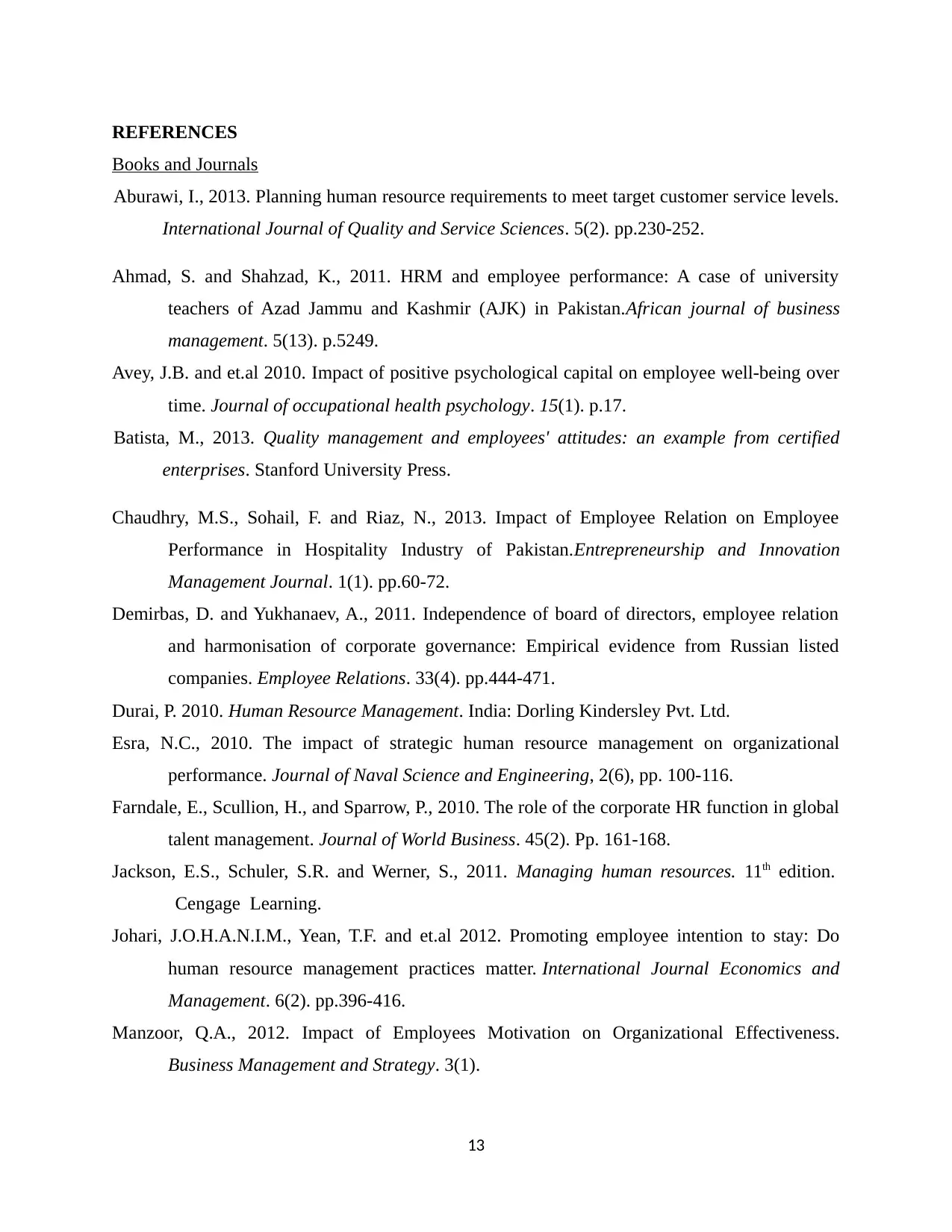
REFERENCES
Books and Journals
Aburawi, I., 2013. Planning human resource requirements to meet target customer service levels.
International Journal of Quality and Service Sciences. 5(2). pp.230-252.
Ahmad, S. and Shahzad, K., 2011. HRM and employee performance: A case of university
teachers of Azad Jammu and Kashmir (AJK) in Pakistan.African journal of business
management. 5(13). p.5249.
Avey, J.B. and et.al 2010. Impact of positive psychological capital on employee well-being over
time. Journal of occupational health psychology. 15(1). p.17.
Batista, M., 2013. Quality management and employees' attitudes: an example from certified
enterprises. Stanford University Press.
Chaudhry, M.S., Sohail, F. and Riaz, N., 2013. Impact of Employee Relation on Employee
Performance in Hospitality Industry of Pakistan.Entrepreneurship and Innovation
Management Journal. 1(1). pp.60-72.
Demirbas, D. and Yukhanaev, A., 2011. Independence of board of directors, employee relation
and harmonisation of corporate governance: Empirical evidence from Russian listed
companies. Employee Relations. 33(4). pp.444-471.
Durai, P. 2010. Human Resource Management. India: Dorling Kindersley Pvt. Ltd.
Esra, N.C., 2010. The impact of strategic human resource management on organizational
performance. Journal of Naval Science and Engineering, 2(6), pp. 100-116.
Farndale, E., Scullion, H., and Sparrow, P., 2010. The role of the corporate HR function in global
talent management. Journal of World Business. 45(2). Pp. 161-168.
Jackson, E.S., Schuler, S.R. and Werner, S., 2011. Managing human resources. 11th edition.
Cengage Learning.
Johari, J.O.H.A.N.I.M., Yean, T.F. and et.al 2012. Promoting employee intention to stay: Do
human resource management practices matter. International Journal Economics and
Management. 6(2). pp.396-416.
Manzoor, Q.A., 2012. Impact of Employees Motivation on Organizational Effectiveness.
Business Management and Strategy. 3(1).
13
Books and Journals
Aburawi, I., 2013. Planning human resource requirements to meet target customer service levels.
International Journal of Quality and Service Sciences. 5(2). pp.230-252.
Ahmad, S. and Shahzad, K., 2011. HRM and employee performance: A case of university
teachers of Azad Jammu and Kashmir (AJK) in Pakistan.African journal of business
management. 5(13). p.5249.
Avey, J.B. and et.al 2010. Impact of positive psychological capital on employee well-being over
time. Journal of occupational health psychology. 15(1). p.17.
Batista, M., 2013. Quality management and employees' attitudes: an example from certified
enterprises. Stanford University Press.
Chaudhry, M.S., Sohail, F. and Riaz, N., 2013. Impact of Employee Relation on Employee
Performance in Hospitality Industry of Pakistan.Entrepreneurship and Innovation
Management Journal. 1(1). pp.60-72.
Demirbas, D. and Yukhanaev, A., 2011. Independence of board of directors, employee relation
and harmonisation of corporate governance: Empirical evidence from Russian listed
companies. Employee Relations. 33(4). pp.444-471.
Durai, P. 2010. Human Resource Management. India: Dorling Kindersley Pvt. Ltd.
Esra, N.C., 2010. The impact of strategic human resource management on organizational
performance. Journal of Naval Science and Engineering, 2(6), pp. 100-116.
Farndale, E., Scullion, H., and Sparrow, P., 2010. The role of the corporate HR function in global
talent management. Journal of World Business. 45(2). Pp. 161-168.
Jackson, E.S., Schuler, S.R. and Werner, S., 2011. Managing human resources. 11th edition.
Cengage Learning.
Johari, J.O.H.A.N.I.M., Yean, T.F. and et.al 2012. Promoting employee intention to stay: Do
human resource management practices matter. International Journal Economics and
Management. 6(2). pp.396-416.
Manzoor, Q.A., 2012. Impact of Employees Motivation on Organizational Effectiveness.
Business Management and Strategy. 3(1).
13
Paraphrase This Document
Need a fresh take? Get an instant paraphrase of this document with our AI Paraphraser
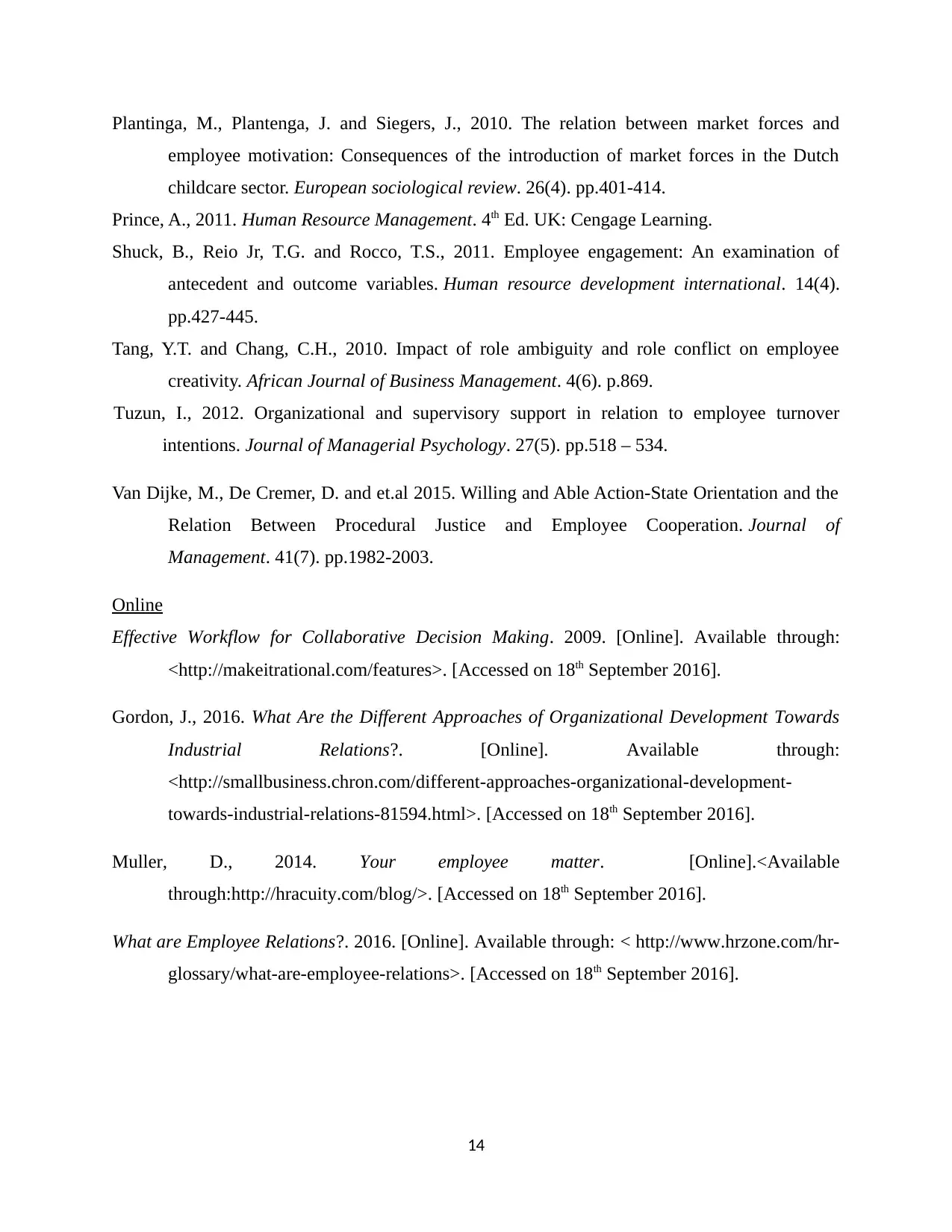
Plantinga, M., Plantenga, J. and Siegers, J., 2010. The relation between market forces and
employee motivation: Consequences of the introduction of market forces in the Dutch
childcare sector. European sociological review. 26(4). pp.401-414.
Prince, A., 2011. Human Resource Management. 4th Ed. UK: Cengage Learning.
Shuck, B., Reio Jr, T.G. and Rocco, T.S., 2011. Employee engagement: An examination of
antecedent and outcome variables. Human resource development international. 14(4).
pp.427-445.
Tang, Y.T. and Chang, C.H., 2010. Impact of role ambiguity and role conflict on employee
creativity. African Journal of Business Management. 4(6). p.869.
Tuzun, I., 2012. Organizational and supervisory support in relation to employee turnover
intentions. Journal of Managerial Psychology. 27(5). pp.518 – 534.
Van Dijke, M., De Cremer, D. and et.al 2015. Willing and Able Action-State Orientation and the
Relation Between Procedural Justice and Employee Cooperation. Journal of
Management. 41(7). pp.1982-2003.
Online
Effective Workflow for Collaborative Decision Making. 2009. [Online]. Available through:
<http://makeitrational.com/features>. [Accessed on 18th September 2016].
Gordon, J., 2016. What Are the Different Approaches of Organizational Development Towards
Industrial Relations?. [Online]. Available through:
<http://smallbusiness.chron.com/different-approaches-organizational-development-
towards-industrial-relations-81594.html>. [Accessed on 18th September 2016].
Muller, D., 2014. Your employee matter. [Online].<Available
through:http://hracuity.com/blog/>. [Accessed on 18th September 2016].
What are Employee Relations?. 2016. [Online]. Available through: < http://www.hrzone.com/hr-
glossary/what-are-employee-relations>. [Accessed on 18th September 2016].
14
employee motivation: Consequences of the introduction of market forces in the Dutch
childcare sector. European sociological review. 26(4). pp.401-414.
Prince, A., 2011. Human Resource Management. 4th Ed. UK: Cengage Learning.
Shuck, B., Reio Jr, T.G. and Rocco, T.S., 2011. Employee engagement: An examination of
antecedent and outcome variables. Human resource development international. 14(4).
pp.427-445.
Tang, Y.T. and Chang, C.H., 2010. Impact of role ambiguity and role conflict on employee
creativity. African Journal of Business Management. 4(6). p.869.
Tuzun, I., 2012. Organizational and supervisory support in relation to employee turnover
intentions. Journal of Managerial Psychology. 27(5). pp.518 – 534.
Van Dijke, M., De Cremer, D. and et.al 2015. Willing and Able Action-State Orientation and the
Relation Between Procedural Justice and Employee Cooperation. Journal of
Management. 41(7). pp.1982-2003.
Online
Effective Workflow for Collaborative Decision Making. 2009. [Online]. Available through:
<http://makeitrational.com/features>. [Accessed on 18th September 2016].
Gordon, J., 2016. What Are the Different Approaches of Organizational Development Towards
Industrial Relations?. [Online]. Available through:
<http://smallbusiness.chron.com/different-approaches-organizational-development-
towards-industrial-relations-81594.html>. [Accessed on 18th September 2016].
Muller, D., 2014. Your employee matter. [Online].<Available
through:http://hracuity.com/blog/>. [Accessed on 18th September 2016].
What are Employee Relations?. 2016. [Online]. Available through: < http://www.hrzone.com/hr-
glossary/what-are-employee-relations>. [Accessed on 18th September 2016].
14
1 out of 14
Related Documents
Your All-in-One AI-Powered Toolkit for Academic Success.
+13062052269
info@desklib.com
Available 24*7 on WhatsApp / Email
![[object Object]](/_next/static/media/star-bottom.7253800d.svg)
Unlock your academic potential
© 2024 | Zucol Services PVT LTD | All rights reserved.





